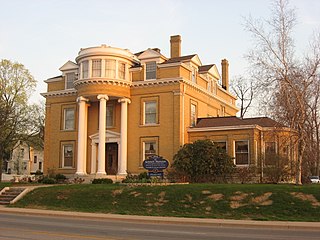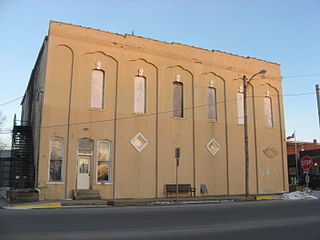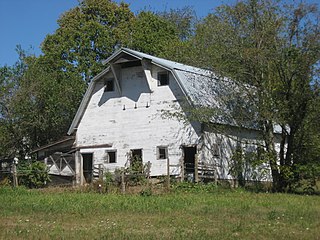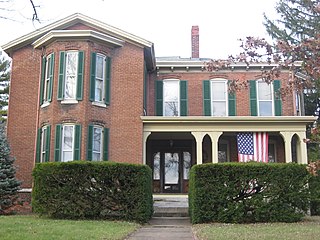
The Riverside Historic District is a U.S. historic district located in downtown Evansville, Indiana. It was added to the register in 1978 and roughly bounded by Southlane Drive, Walnut, Third, and Parrett Streets. It consists of 1,010 acres (4.1 km2) and 425 buildings. It is also known as the Riverside Neighborhood.

The East Main Street–Glen Miller Park Historic District is a neighborhood of historic residential buildings and national historic district located at Richmond, Wayne County, Indiana. The district encompasses 84 contributing buildings, 11 contributing structures, and 5 contributing objects along the National Road and sometimes called Millionaire's Row. A portion of the district is recognized by the City of Richmond's Historic Preservation Commission as the Linden Hill conservation district. It developed between about 1830 and 1937 and includes representative examples of Italianate, Queen Anne, Colonial Revival, Tudor Revival, Classical Revival, and Bungalow / American Craftsman style architecture. Located in the district is the separately listed Henry and Alice Gennett House. Other notable contributing resources include elaborate iron bridges and "Madonna of the Trail" statue located in Glen Miller Park, Isham Sedgwick House (1884-1885), John A. Hasecoster House (1895), William H. Campbell House (1905), Howard Campbell House (1909), E.G. Hill House, Crain Sanitarium, and Dr. T. Henry Davis House.

Vincennes Historic District is a national historic district located at Vincennes, Knox County, Indiana. The district encompasses 1,161 contributing buildings, 5 contributing sites, 9 contributing structures, and 37 contributing objects in the central business district and surrounding residential sections of Vincennes. It developed between about 1787 and 1955, and includes notable examples of Federal, Greek Revival, Italianate, and Classical Revival style architecture. Located in the district are the separately listed George Rogers Clark National Historical Park, William Henry Harrison Home, Indiana Territorial Capitol, Old State Bank, and St. Francis Xavier Cathedral and Library. Other notable buildings include the Brouillet House, Knox County Courthouse (1873), Ellis Mansion, Lacy House, Dunn House (1840), Summers House, Fyfield House (1860), Grannan House, Cauthorn House, Gimble-Bond Store (1879), and Rabb House.

Silver Lake Historic District is a national historic district located at Silver Lake, Kosciusko County, Indiana. The district encompasses 19 contributing buildings in the central business district and surrounding residential section of Silver Lake. It developed between about 1865 and 1920, and includes notable examples of Italianate, Romanesque Revival, Classical Revival, and Early Commercial style architecture. Notable buildings include the former Enos Hotel, Municipal Building, and buildings on North Jefferson and East Main streets.

Franklin Street Commercial Historic District is a national historic district located at Michigan City, LaPorte County, Indiana. The district encompasses 73 contributing buildings and 1 contributing object in the central business district and surrounding residential section of Michigan City. It developed between about 1875 and 1955, and includes examples of Italianate, Gothic Revival, Queen Anne, Classical Revival, and Tudor Revival style architecture. Located in the district is the separately listed Michigan City Post Office (1909-1910). Other notable buildings include the Staiger House, Earl House, M & M Diner (1955), Zorn Building (1907), St. Paul's Lutheran Church (1876) and rectory (1888), First Federal Savings Bank, Aicher Block (1914), Brinkman Building, Trinity Episcopal Church (1889), Merchants National Bank Building (1926), Ledbetter Building (1908), Rodenbeck Saloon, First Methodist Episcopal Church (1922), Barker Hall (1929), Masonic Temple (1922-1923), and the Salvation Army Building (1925).

East Shore Historic District, also known as Lake Maxinkuckee Historic District, is a national historic district located in Union Township, Marshall County, Indiana. The district encompasses 114 contributing buildings, 3 contributing sites, and 1 contributing structure in a resort development along the shore of Lake Maxinkuckee. It developed between about 1873 and 1945, and includes examples of Late Victorian, Colonial Revival, and Bungalow / American Craftsman style architecture. The district includes Maxinkuckee Country Club. Notable buildings include the Norris Farmhouse, Trone Cottage, Roach-Rockwood Cottage, Elliott Cottage, Gates-Holliday Cottage (1897), Marmon Cottage, and Norman Perry House.

Plymouth Northside Historic District is a national historic district located at Plymouth, Marshall County, Indiana. The district encompasses 141 contributing buildings, 2 contributing sites, 6 contributing structures, and 3 contributing objects in a predominantly residential section of Plymouth. It developed between about 1870 and 1940, and includes examples of Italianate, Gothic Revival, Queen Anne, Colonial Revival, Tudor Revival, Neoclassical, and Renaissance Revival style architecture. Located in the district is the separately listed Marshall County Courthouse. Other notable contributing resources include Magnetic Park, First United Methodist Church (1914-1915), J.C. Capron House (1900), Samuel Schlosser House (1910-1911), Clay Metsker House (1917-1918), Plymouth Church of the Brethren (1950-1951), Logan-Stanley Fountain, Stevens House (1895), and First Presbyterian Church (1896-1897).

Plymouth Southside Historic District is a national historic district located at Plymouth, Marshall County, Indiana. The district encompasses 91 contributing buildings, 2 contributing structures, and 1 contributing object in a predominantly residential section of Plymouth. It developed between about 1853 and 1953, and includes examples of Italianate, Greek Revival, Queen Anne, Colonial Revival, and Tudor Revival style architecture. Notable contributing resources include the John McFarlin, Jr., House, Trinity United Methodist Church (1926), Bible Baptist Church (1894), Felke Florist and Greenhouse (1922), John Soice Residence, Westervelt-Marble Residence, and Edwards-Gambel Residence (1856).

North Washington Street Historic District is a national historic district located in the city of Bloomington of Monroe County, Indiana. The district encompasses 35 contributing buildings and 6 contributing structures in a predominantly residential section of Bloomington. It developed between roughly 1870 and 1929, and includes notable examples of Queen Anne, Classical Revival, and Bungalow/American Craftsman style architecture. Located in the district is the separately listed Morgan House. Other notable buildings include the Showers-Graham House, Showers-Myers House, Teter House, and Washington Terrace Apartments (1929).

Prospect Hill Historic District is a national historic district located at Bloomington, Monroe County, Indiana. The district encompasses 38 contributing buildings and 8 contributing structures in a predominantly residential section of Bloomington. It developed between about 1840 and 1936, and includes notable examples of Queen Anne, Colonial Revival, Tudor Revival, Mission Revival, and Bungalow/American Craftsman style architecture. Located in the district is the separately listed Blair-Dunning House.

Maple Grove Road Rural Historic District is a national historic district located in Bloomington Township and Richland Township, Monroe County, Indiana. The district encompasses 69 contributing buildings, 7 contributing sites, 8 contributing structures, and 30 contributing objects in a rural area near Bloomington. The district developed between about 1828 and 1950, and include notable examples of Gothic Revival and Greek Revival style architecture. The contributing elements are located on 12 farmsteads. Located in the district is the separately listed Daniel Stout House.

Martinsville Commercial Historic District is a national historic district located at Martinsville, Morgan County, Indiana. The district encompasses 75 contributing buildings and 1 contributing object in the central business district of Martinsville. It developed between about 1847 and 1947, and includes notable examples of Italianate, Classical Revival, and Tudor Revival style architecture. Located in the district are the separately listed Morgan County Courthouse and Blackstone House and Martinsville Telephone Company Building. Other notable buildings are the Martinsville Public Library, Martinsville City Hall (1917), Martinsville Post Office, Pitkin Building, Barskin's Department Store (1922), Indiana Theater, Steven's House / Building, Hale Building, Interurban Station, Union Block (1866), and First Christian Church (1891) and Annex (1927).

Martinsville Northside Historic District is a national historic district located at Martinsville, Morgan County, Indiana. The district encompasses 96 contributing buildings and 11 contributing structures in a predominantly residential section of Martinsville. It developed between about 1850 and 1935, and includes notable examples of Queen Anne and Bungalow/American Craftsman style architecture. Notable buildings include the Brown-Haworth House, William R. Harrison House / Bates House, St. Martin of Tours Roman Catholic Church (1889), Elliott House (1865), Kriner House, and Schofield-Maxwell House. The formerly listed Hite-Finney House was located in the district.

East Washington Street Historic District is a national historic district located at South Bend, St. Joseph County, Indiana. It encompasses 71 contributing buildings and 1 contributing structure in a predominantly residential section of South Bend. It developed between about 1880 and 1947, and includes notable examples of Italianate, Colonial Revival, American Foursquare, and Bungalow / American Craftsman style architecture and works by architects Austin & Shambleau. Notable buildings include the James and Marie Zimmerman House (1921), Eger House (1911), George and Emma Hewitt House (1905), Ruth and Edwin H. Sommerer House (1930), Chauncey T. Fassett House (1898), Dougdale Carriage Barn (1900), and Sunnyside Presbyterian Church.

West Washington Historic District is a national historic district located at South Bend, St. Joseph County, Indiana. It encompasses 330 contributing buildings in an upper class residential section of South Bend. It developed between about 1854 and 1910, and includes notable examples of Italianate, Greek Revival, and Romanesque Revival style architecture. Located in the district are the separately listed Morey-Lampert House, Oliver Mansion designed by Lamb and Rich, Second St. Joseph County Courthouse, South Bend Remedy Company Building, and Tippecanoe Place. Other notable buildings include the Bartlett House (1850), Birdsell House (1897), DeRhodes House designed by Frank Lloyd Wright, Holley House, Kaiser-Schmidt House, Listenberger-Nemeth House, Meahger-Daughterty House (1884), O'Brien House, Oren House, The People's Church (1889), St. Hedwig's Church, St. Patrick's Church (1886), St. Paul's Memorial United Methodist Church (1901), West House, and a rwo of worker's house.

Highland Park Neighborhood Historic District is a national historic district located at Lafayette, Tippecanoe County, Indiana. The district encompasses 240 contributing buildings, 1 contributing site, and 1 contributing structure in a planned residential subdivision of Lafayette. It developed between about 1892 and 1945 and includes representative examples of Queen Anne, Tudor Revival, and Bungalow / American Craftsman style architecture. Notable contributing resources include the Blistain Axel Merritt House (1914), John Wagner Jr. House, John Ross House, and Bicycle Bridge (1924).

Jefferson Historic District is a national historic district located at Lafayette, Tippecanoe County, Indiana. The district encompasses 161 contributing buildings, 2 contributing sites, and 22 contributing structures in a predominantly residential section of Lafayette. It developed between about 1853 and 1951 and includes representative examples of Italianate, Greek Revival, and Bungalow / American Craftsman style architecture. Notable contributing resources include the Deutsche Evangelische Kirche (1905), Isador Metzger House, Hubert Gilmartin House, B.F. Biggs Pump Factory Building, Deutsche Methodist Kirche (1885), Herman & Mary Fletemeyer House, Mohr House, Warrenberg-Reule Double House, Alfred Gaddis House, Wabash Valley House (1862), Haywood Tag Company Building (1928), and Jefferson High School (1927).

Ninth Street Hill Neighborhood Historic District is a national historic district located at Lafayette, Tippecanoe County, Indiana. The district encompasses 88 contributing buildings and 6 contributing structures in a predominantly residential section of Lafayette. It developed between about 1850 and 1946 and includes representative examples of Gothic Revival, Italianate, Queen Anne, Greek Revival, and Second Empire style architecture. Located in the district is the separately listed Judge Cyrus Ball House. Other notable contributing resources include the Samuel Moore House (1891), Moore-Porter-Boswell House (1895), Stanley Coulter House (1890), Edward Bohrer House (1909), Thomas Wood House, Job M. Nash House (1859), and Gordon Graham House.

Perrin Historic District is a national historic district located at Lafayette, Tippecanoe County, Indiana. The district encompasses 173 contributing buildings and 2 contributing structures in a predominantly residential section of Lafayette. It developed between about 1869 and 1923 and includes representative examples of Italianate, Queen Anne, Colonial Revival, Stick Style / Eastlake Movement, and Bungalow / American Craftsman style architecture. Notable contributing buildings include the James Perrin House, John Heinmiller House, James H. Cable House, Adam Herzog House (1878), Coleman-Gude House (1875), Frank Bernhardt House (1873), August Fisher Cottage, John Beck House (1887), an William H. Sarles Bungalow (1923).

North Meridian Street Historic District is a national historic district located at Indianapolis, Indiana. It encompasses 169 contributing buildings in a high style residential section of Indianapolis. The district developed between about 1900 and 1936, and includes representative examples of Tudor Revival, Colonial Revival, and Classical Revival style architecture. Located in the district is the separately listed William N. Thompson House. Other notable contributing resources include the Evan-Blankenbaker House (1901), Sears-Townsend House (1930), MacGill-Wemmer House, Hugh Love House (1930), Hare-Tarkington House (1911), Shea House (1922), and Brant-Weinhardt House (1932).
























